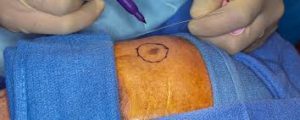‘Slip, slop, slap’ is synonymous with playing it safe in the sun whether at work or play, but new research tells a different story for those affected by rarer forms of melanoma
The genetic study has found that melanomas on the hands and feet (known as acral) and internal surfaces (known as mucosal) are not linked to ultraviolet (UV) radiation – in contrast to melanoma of the skin, which is strongly related to UV radiation.
Researchers at Melanoma Institute Australia, QIMR Berghofer Medical Research Institute and The University of Sydney discovered that acral and mucosal melanoma have different causes to skin melanoma.
“This is by far the largest study to have looked at the whole genome in melanoma, and it has proven these less common melanomas are strikingly different in terms of their causes,” says Professor Richard Scolyer, Conjoint Medical Director of Melanoma Institute Australia and a lead author.
The research is particularly pertinent to New Zealand, which has the highest melanoma incidence rate in the world, with over 4000 people diagnosed with either melanoma in situ or invasive melanoma every year – around 13 per day.
It accounts for nearly 80 per cent of all skin cancer deaths, killing over 300 New Zealanders every year.
Acral or mucosal melanomas affect people of all ethnic backgrounds, and are the most common forms of melanoma in people with very dark skin.
These forms of melanoma often behave more aggressively, are harder to diagnose and have a poorer outcome compared to skin melanoma.
Treatment for skin melanoma has advanced rapidly in recent years, with therapies tripling the life expectancy of some advanced melanoma patients.
For the first time, this research sheds light on why revolutionary treatments don’t work as well for acral or mucosal melanomas.
“Acral and mucosal melanomas occur all over the world, but they have been even more challenging to treat than skin melanoma,” says Professor Nicholas Hayward, a lead author from QIMR Berghofer Medical Research Institute.
“Knowing these are really different diseases to skin melanoma is important for development of future therapies.”
The study also found acral and mucosal melanomas have much less gene damage compared with skin melanoma and the damage “footprints” did not match those of any known causes of cancer, like sun exposure.
This means more research to discover what is causing these cancers, and what can prevent them.
While they had fewer gene drivers that could be targeted for therapy, new ones were found.
Some mucosal melanomas unexpectedly had mutations in the SF3B1 and GNAQ genes, which had previously only been connected to melanoma of the eye.
Understanding which gene mutations are driving an individual tumour is the basis of personalised cancer medicine.
This is the first study to survey the entire DNA sequence of melanomas, not just the genes themselves, giving 50 times more information than in previous work.
Many genes were found to have damage in their control regions, the so-called “dark matter” of our genome, and these may be previously unsuspected drivers of melanoma.
The incidence of acral and mucosal melanoma is equal among different races, but it is the most common melanoma subtype in dark-skinned populations due to the rarity of skin melanoma.
Acral melanoma occurs on the soles of the feet, palms and nails (most commonly on the feet). Mucosal melanoma occurs in mucous membrane lining the respiratory, gastrointestinal and urogenital tract.
Most mucosal melanomas originate in the nasal cavity and sinuses, oral cavity, anorectum, vulva and vagina.
Acral and mucosal melanomas are often diagnosed at an advanced stage as they are harder to detect.
Treatment options are often less effective than for other forms of skin melanoma, so prognosis is often poor.




